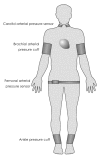Arterial stiffness in the young: assessment, determinants, and implications
- PMID: 20421954
- PMCID: PMC2859331
- DOI: 10.4070/kcj.2010.40.4.153
Arterial stiffness in the young: assessment, determinants, and implications
Abstract
Arterial stiffness describes the rigidity of the arterial wall. Its significance owes to its relationship with the pulsatile afterload presented to the left ventricle and its implications on ventricular-arterial coupling. In adults, the contention that arterial stiffness as a marker and risk factor for cardiovascular morbidity and mortality is gaining support. Noninvasive methods have increasingly been adopted in both the research and clinical arena to determine local, segmental, and systemic arterial stiffness in the young. With adoption of these noninvasive techniques for use in children and adolescents, the phenomenon and significance of arterial stiffening in the young is beginning to be unveiled. The list of childhood factors and conditions found to be associated with arterial stiffening has expanded rapidly over the last decade; these include traditional cardiovascular risk factors, prenatal growth restriction, vasculitides, vasculopathies associated with various syndromes, congenital heart disease, and several systemic diseases. The findings of arterial stiffening have functional implications on energetic efficiency, structure, and function of the left ventricle. Early identification of arterial dysfunction in childhood may provide a window for early intervention, although longitudinal studies are required to determine whether improvement of arterial function in normal and at-risk paediatric populations will be translated into clinical benefits.
Keywords: Arteriosclerosis; Children.
Figures



Similar articles
-
[Arterial compliance (stiffness) as a marker of subclinical atherosclerosis].Herz. 2007 Aug;32(5):379-86. doi: 10.1007/s00059-007-3030-z. Herz. 2007. PMID: 17687527 Review. German.
-
Relation of arterial stiffness to left ventricular structure and function in adolescents and young adults with pediatric-onset systemic lupus erythematosus.J Rheumatol. 2007 Jun;34(6):1345-52. Epub 2007 May 1. J Rheumatol. 2007. PMID: 17477468
-
Arterial stiffness and function in end-stage renal disease.Adv Chronic Kidney Dis. 2004 Apr;11(2):202-9. doi: 10.1053/j.arrt.2004.02.008. Adv Chronic Kidney Dis. 2004. PMID: 15216492 Review.
-
New insights into arterial stiffening: does sex matter?Am J Physiol Heart Circ Physiol. 2018 Nov 1;315(5):H1073-H1087. doi: 10.1152/ajpheart.00132.2018. Epub 2018 Jul 20. Am J Physiol Heart Circ Physiol. 2018. PMID: 30028199 Free PMC article. Review.
-
Assessment and significance of arterial stiffness in patients with chronic kidney disease.Curr Opin Nephrol Hypertens. 2008 Nov;17(6):635-41. doi: 10.1097/mnh.0b013e32830dcd5c. Curr Opin Nephrol Hypertens. 2008. PMID: 19031658 Review.
Cited by
-
Relationships between Dietary Patterns and Indices of Arterial Stiffness and Central Arterial Wave Reflection in 9-11-Year-Old Children.Children (Basel). 2020 Jun 25;7(6):66. doi: 10.3390/children7060066. Children (Basel). 2020. PMID: 32630564 Free PMC article.
-
Evaluation of carotid artery dynamics & correlation with cardiac & hepatic iron in β-thalassaemia patients.Indian J Med Res. 2016 Apr;143(4):443-8. doi: 10.4103/0971-5916.184302. Indian J Med Res. 2016. PMID: 27377500 Free PMC article.
-
Is infant arterial stiffness associated with maternal blood pressure in pregnancy? Findings from a UK birth cohort (Baby VIP study).PLoS One. 2018 Jul 12;13(7):e0200159. doi: 10.1371/journal.pone.0200159. eCollection 2018. PLoS One. 2018. PMID: 30001353 Free PMC article.
-
Unveiling the Silent Danger of Childhood Obesity: Non-Invasive Biomarkers Such as Carotid Intima-Media Thickness, Arterial Stiffness Surrogate Markers, and Blood Pressure Are Useful in Detecting Early Vascular Alterations in Obese Children.Biomedicines. 2023 Jun 26;11(7):1841. doi: 10.3390/biomedicines11071841. Biomedicines. 2023. PMID: 37509481 Free PMC article.
-
Pulse wave analyzed cardiovascular parameters in young first degree relatives of type 2 diabetics- a cross-sectional study.Indian Heart J. 2018 May-Jun;70(3):341-345. doi: 10.1016/j.ihj.2017.08.013. Epub 2017 Aug 26. Indian Heart J. 2018. PMID: 29961447 Free PMC article.
References
-
- Laurent S, Hayoz D, Trazzi S, et al. Isobaric compliance of the radial artery is increased in patients with essential hypertension. J Hypertens. 1993;11:89–98. - PubMed
-
- Laurent S, Cockcroft J, Van Bortel L, et al. Expert consensus document on arterial stiffness: methodological issues and clinical applications. Eur Heart J. 2006;27:2588–2605. - PubMed
-
- Mackenzie IS, Wilkinson IB, Cockcroft JR. Assessment of arterial stiffness in clinical practice. QJM. 2002;95:67–74. - PubMed
-
- Oliver JJ, Webb DJ. Noninvasive assessment of arterial stiffness and risk of atherosclerotic events. Arterioscler Thromb Vasc Biol. 2003;23:554–566. - PubMed
-
- Zieman SJ, Melenovsky V, Kass DA. Mechanisms, pathophysiology, and therapy of arterial stiffness. Arterioscler Thromb Vasc Biol. 2005;25:932–943. - PubMed
LinkOut - more resources
Full Text Sources

